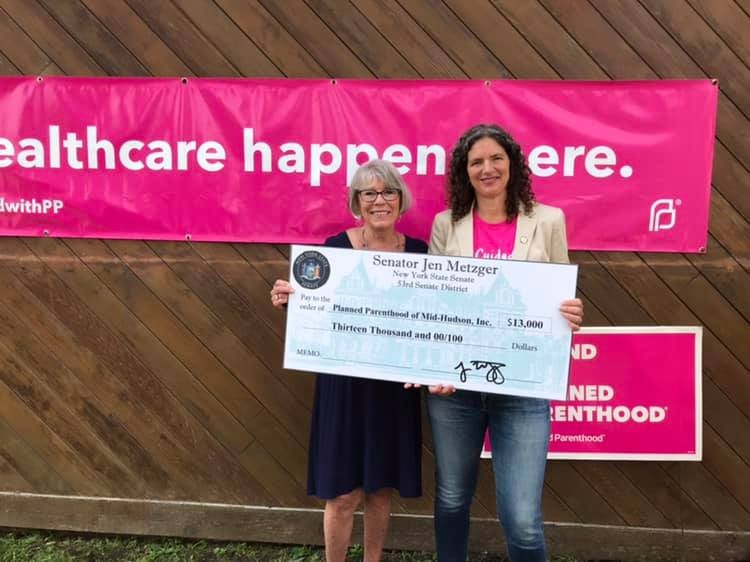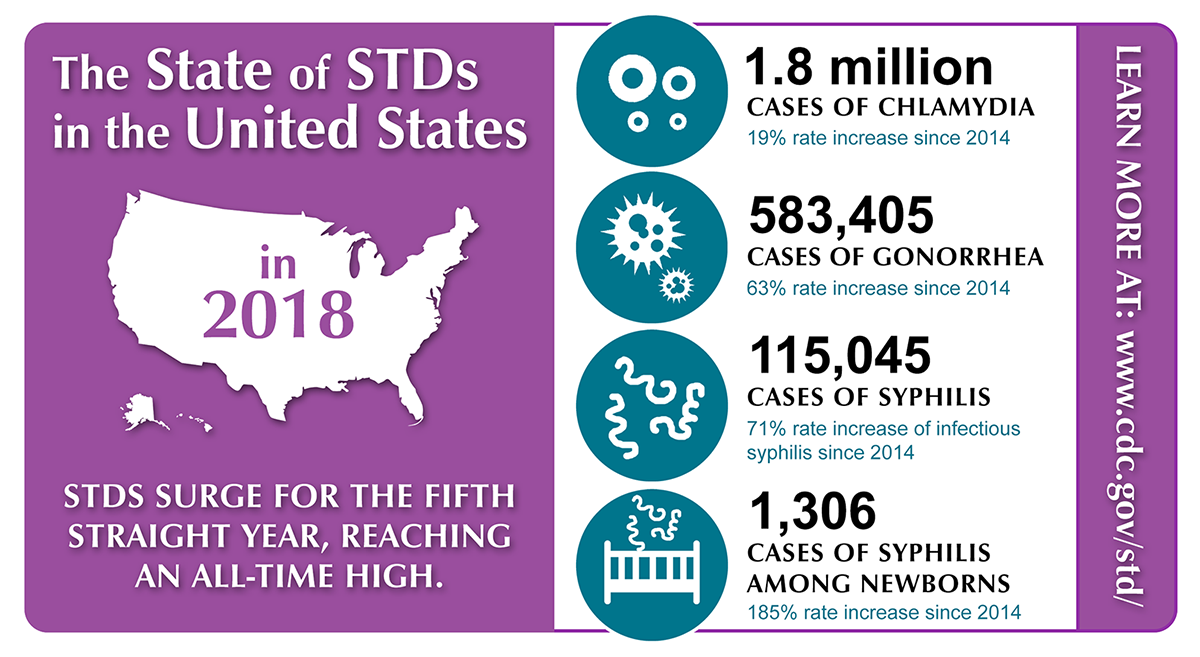It sometimes seems like there’s no good news about the state of health in the United States in 2019. Opioids are an epidemic. Teen smoking is skyrocketing. Our life expectancy declined every year from 2013 to 2018. We spend more on health care than comparable countries around the globe, but have worse health outcomes. And so on.
We hate to pile on, but there’s an under-discussed, gloomy statistic: sexually transmitted diseases are on the rise. According to the most recent STD surveillance report from the Centers for Disease Control and Prevention, over the past five years, cases of chlamydia have increased by 19 percent; gonorrhea by 63 percent; primary and secondary syphilis by 71 percent; and congenital syphilis—which is when the disease is transmitted in utero—by an astonishing 185 percent. 2018 was the fifth straight year in which STDs reached an all-time high, and New York State fares worse than average in all four STDs the CDC measured.
This, at a time when Americans are having less sex. So what’s going on? Last year (after the 2017 CDC report), The Atlantic named a “rise in condom-less sex and a rise in high-risk sexual behaviors associated with opioid use and addiction” as two of the main culprits. Scientists are also getting better at detecting cases, at the same time that tracking and containing outbreaks is more difficult given the rise in high-risk casual sex abetted by dating apps.
But the record rates of STDs in America is indicative of our commitment, or lack thereof, to public health education. As of 2012, only three percent of the government’s health budget is spent on public health measures. The Affordable Care Act attempted to boost that spending with the Prevention and Public Health Fund, but budget cuts have slashed the overall fund by more than half since 2010, putting a strain on the public health sector, which has lost more than 50,000 jobs over the past 10 years and had many clinics close or reduce their hours. As Vox notes:
STD clinics were a traditional safety net for people with these diseases. If those clinics continue to be harder to reach or vanish, finding and treating STDs will become even more difficult—and the diseases will continue to spread.
So in some ways, the STD increases across the country may have less to do with a changing sexual landscape and more to do with more limited access to sexual health care.
Planned Parenthood, Title X, and Declining Outcomes
But of course, sexual health clinics not only treat disease—they’re also education centers that help people learn how to practice safe sex and prevent infections. That role is increasingly important as sexual education in schools worsens due to poor funding and the increased prevalence of abstinence-only teaching, which has been shown to be ineffective.
That leaves a huge knowledge and safety gap, which organizations like Planned Parenthood are attempting to fill. Writing for The Atlantic, health journalist Angela Lashbrook notes:
Planned Parenthood, which in 2017 facilitated 4.4 million STD tests, addressed the crushing effect of budget cuts on providing people access to treatment. “Improving people’s access to health care and preventing public-health crises like rising STD rates require that policy makers invest in making STD testing and treatment more accessible, not less,” says Gillian Dean, the senior director of medical services at Planned Parenthood.
In July, I wrote an in-depth story for The River and Chronogram that looked at the state of sex education in New York. Because the state has not adopted comprehensive standards for public schools, many districts end up providing “sex-ed instruction that is inaccurate, incomplete, and biased,” as a 2012 New York Civil Liberties Union report put it.
Like elsewhere in the country, a local Planned Parenthood chapter stepped up. Jessie Moore, director of sexuality education for Planned Parenthood Mid-Hudson Valley (PPMHV), detailed the programs and initiatives that the chapter provides to schools, free of charge, although there were fewer offerings than in previous years because the Trump administration had slashed funds for the Title X Family Planning Program.
What didn’t make it into the story is that Moore was concerned about the future availability of even these attenuated Title X funds. And less than a month later, the Trump administration issued a new rule barring Title X recipients from making referrals for an abortion. Rather than comply with the rule, Planned Parenthood decided to withdraw from the program.
It’s a costly decision that could have lasting consequences. Planned Parenthood gets about one-third of its revenue from federal funding, most of which comes from patients’ Medicaid coverage. But the organization still receives about $60 million annually through Title X, and it treats about 40 percent of the four million-plus people every year who rely on Title X funding, mostly for basic primary and preventive health care services like wellness exams, cancer screenings, birth control, contraception, and STD/HIV testing. In some rural communities, Planned Parenthood is the only provider of such services.
Public health advocates reacted with immediate concern, warning that the record-high STD rates could worsen. And, a few months out, we’re starting to get a picture of what the effects are: According to a recent study from Power to Decide, an unplanned pregnancy-prevention organization, 876 clinics across the nation have lost funding from the federal family-planning program, including 92 percent of all clinics in New York State that received Title X money.

Planned Parenthood, the American Medical Association, and more than 20 states are appealing the Trump administration’s ruling, but in the meantime, states and private donations are going to have to make up the gap. And that’s where there is a glimmer of hope, at least locally. In August, State Senator Jen Metzger (D-Rosendale) secured $13,000 for Planned Parenthood through the New York State Department of Health Women’s Health Grant, which she presented in the form of an oversized check to Ruth-Ellen Blodgett, president and CEO of PPMHV. Speaking at Monticello Health Center, Blodgett also said that PPMHV is joining forces with Planned Parenthood chapters in New York City, Nassau County, the Mohawk-Hudson region, and the Southern Finger Lakes to create a network of sorts, reducing duplicative efforts and reallocating financial resources from the wealthier affiliates to more rural ones.
“I think the hardest thing for us to absorb is the fact that the money that we get from New York, that was mixed with the federal dollars, really allows a woman or other individuals to access our services if they have zero income,” Blodgett said. “We can offset that cost.”
Phillip Pantuso is the editor of The River, and has contributed to the Guardian, the New York Times, and Yes! Magazine. Follow him on Twitter @phillippantuso.














